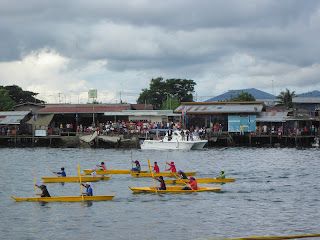Some woolen shawls bought at Tie Rack, every time I passed through KLIA. Airports are 'cold' right? (Actually this is just an excuse to acquire shawls).
 |
Some more of the same as the above, except the white and the dark pink are the only real 'Pashmina'* in my wardrobe. I also have several cotton shawls/selendang in most colours of the rainbow.
 |
My wedding selendang - white lace. I guess it is an antique piece now! Once a bit of it was dragged through a street in Kota Baru when it got caught in the car door. (I was in KB to attend my brother's wedding). Luckily the selendang survived.
 |
This is a Batak woven cotton shawl bought in Sumatra in 1976, (though M keeps saying it is actually a piece of 'long', or kain basahan the Iranians wear in their public baths. Excuse me, I don't think so!)
A woolen lace shawl I bought in Greece. It has been in storage for a long time but now decorates one of my bedposts because it has proven too 'itchy' to wear over the shoulders! Any remedies for this?
A rather 'loud' Kurdish silk shawl that is so big that I also use it as a tablecloth sometimes! The blue background is electric! I bought it in a street of Kermanshah, Iran from a Kurdish lady.
A Thai tie & dye silk shawl acquired during one of the Conferences attended in Bangkok. The colour is a purple pink with gold motifs.
A very sheer Chinese silk scarf with butterfly motifs. Acquired during a visit to a silk factory/shop in Beijing.
A shawl made of natural pineapple fibre and embroidered with little beads and pearls. My Filipino good friend gave me this, thank you very much. Its an exquisite treasure!
A blue/white batik Habutai silk scarf bought at the Ubud market in Bali. But you can find these aplenty in Malaysia.
A pink/grey cotton & wool shawl, bought in India last year. The motif is traditional paisley and flora.
A Spanish embroidered shawl from Madrid. I received it as a gift from a close family member, terima kasih daun keladi, kalau boleh, bagi lagi! (Bad translation: Thank you Caladium leaf, If can, give more!)
*Pashmina is the cashmere wool of the under-hair of the Himalayan mountain goats native to the Kashmir region.

























































